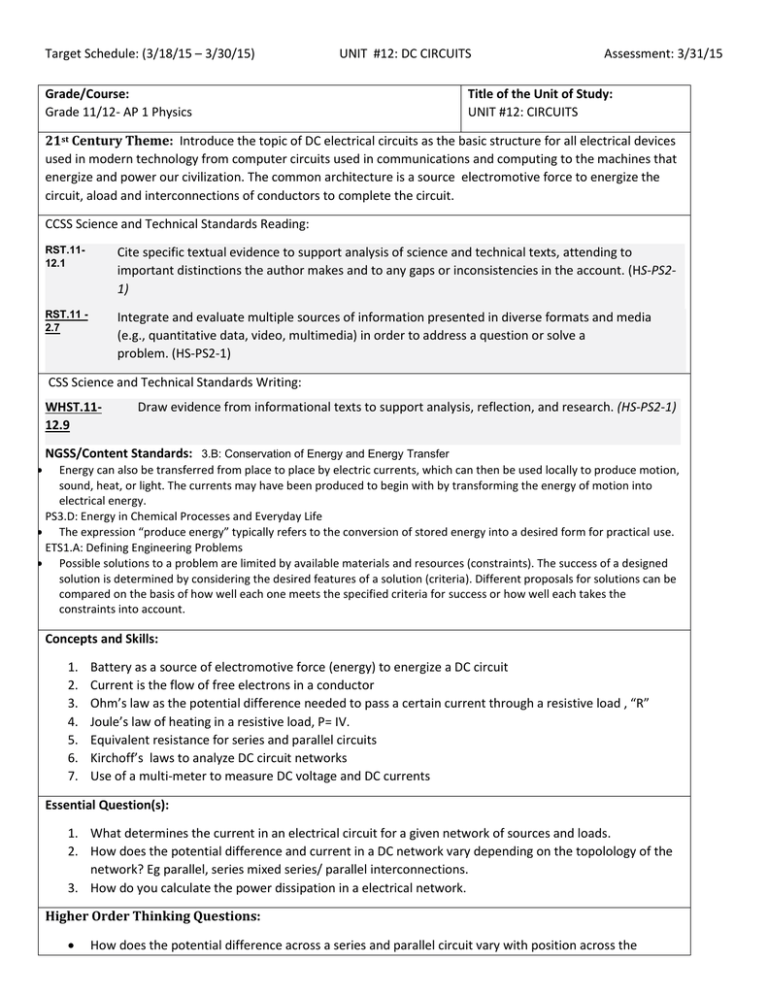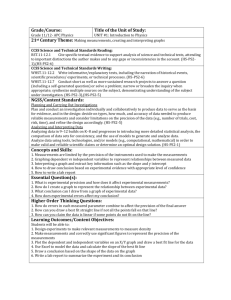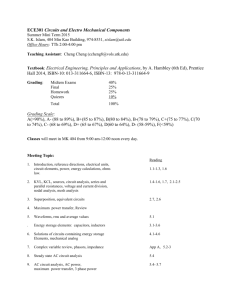AP1 _ Unit #12: DC CIRCUITS
advertisement

Target Schedule: (3/18/15 – 3/30/15) UNIT #12: DC CIRCUITS Grade/Course: Grade 11/12- AP 1 Physics Assessment: 3/31/15 Title of the Unit of Study: UNIT #12: CIRCUITS 21st Century Theme: Introduce the topic of DC electrical circuits as the basic structure for all electrical devices used in modern technology from computer circuits used in communications and computing to the machines that energize and power our civilization. The common architecture is a source electromotive force to energize the circuit, aload and interconnections of conductors to complete the circuit. CCSS Science and Technical Standards Reading: RST.1112.1 Cite specific textual evidence to support analysis of science and technical texts, attending to important distinctions the author makes and to any gaps or inconsistencies in the account. (HS-PS21) RST.11 2.7 Integrate and evaluate multiple sources of information presented in diverse formats and media (e.g., quantitative data, video, multimedia) in order to address a question or solve a problem. (HS-PS2-1) CSS Science and Technical Standards Writing: WHST.1112.9 Draw evidence from informational texts to support analysis, reflection, and research. (HS-PS2-1) NGSS/Content Standards: 3.B: Conservation of Energy and Energy Transfer Energy can also be transferred from place to place by electric currents, which can then be used locally to produce motion, sound, heat, or light. The currents may have been produced to begin with by transforming the energy of motion into electrical energy. PS3.D: Energy in Chemical Processes and Everyday Life The expression “produce energy” typically refers to the conversion of stored energy into a desired form for practical use. ETS1.A: Defining Engineering Problems Possible solutions to a problem are limited by available materials and resources (constraints). The success of a designed solution is determined by considering the desired features of a solution (criteria). Different proposals for solutions can be compared on the basis of how well each one meets the specified criteria for success or how well each takes the constraints into account. Concepts and Skills: 1. 2. 3. 4. 5. 6. 7. Battery as a source of electromotive force (energy) to energize a DC circuit Current is the flow of free electrons in a conductor Ohm’s law as the potential difference needed to pass a certain current through a resistive load , “R” Joule’s law of heating in a resistive load, P= IV. Equivalent resistance for series and parallel circuits Kirchoff’s laws to analyze DC circuit networks Use of a multi-meter to measure DC voltage and DC currents Essential Question(s): 1. What determines the current in an electrical circuit for a given network of sources and loads. 2. How does the potential difference and current in a DC network vary depending on the topolology of the network? Eg parallel, series mixed series/ parallel interconnections. 3. How do you calculate the power dissipation in a electrical network. Higher Order Thinking Questions: How does the potential difference across a series and parallel circuit vary with position across the Target Schedule: (3/18/15 – 3/30/15) UNIT #12: DC CIRCUITS Assessment: 3/31/15 network? In what way does the internal resistance in a battery affect the power and current properties of DC circuit? What is the optimal efficiency in transferring electrical power to a load? Learning Outcomes/Content Objectives: 1. Explain how a simple battery can produce an electrical current. 2. Define current, ampere, emf, voltage, resistance, resistivity, and temperature coefficient of resistance. 3. Write the symbols used for electromotive force, electric current, resistance, resistivity, temperature coefficient of resistance and power and state the unit associated with each quantity. 4. Distinguish between a) conventional current and electron current and b) direct current and alternating current. 5. Know the symbols used to represent a source of emf, resistor, voltmeter, and ammeter and how to interpret a simple circuit diagram. 6. Given the length, cross sectional area, resistivity, and temperature coefficient of resistance, determine a wire's resistance at room temperature and some higher or lower temperature. 7. Solve simple dc circuit problems using Ohm's law. 8. Use the equations for electric power to determine the power and energy dissipated in a resistor and calculate the cost of this energy to the consumer. 9. Distinguish between the rms and peak values for current and voltage and apply these concepts in solving problems involving a simple ac circuit Objectives - Circuits After studying the material of this chapter, the student should be able to: 1. Determine the equivalent resistance of resistors arranged in series or in parallel or the equivalent resistance of a series parallel combination. 2. Use Ohm's law and Kirchhoff's rules to determine the current through each resistor and the voltage drop across each resistor in a single loop or multiloop dc circuit. 3. Distinguish between the emf and the terminal voltage of a battery and calculate the terminal voltage given the emf, internal resistance of the battery, and external resistance in the circuit Academic Vocabulary: - Content Specific Vocabulary: Current as measured in amps Multi- meter Ohm_meter Volt_meter Ammeter Resistance measured in ohms Voltage measured in Volts Ohm’s Law V = IR Joule’s Law: P = IV Power measured in watts Kirchoff’s Laws Series and parallel circuits Labs/Demonstrations/Activities: 1. Series/ Parallel circuit lab 2. PHET circuit simulation lab 3. Rope loop to model current, battery, resistor functions Sentence Frames: The power in a electrical load is given as a the product ……….. and is measured in ………….. It represents the rate at which electrical …………… is used up in the component. Target Schedule: (3/18/15 – 3/30/15) UNIT #12: DC CIRCUITS Resources: Web quiz: http://cwx.prenhall.com/bookbind/pubbooks/giancoli/chapter18/deluxe.html http://cwx.prenhall.com/bookbind/pubbooks/giancoli/chapter19/deluxe.html Assessment: 3/31/15 Simulations: https://phet.colorado.edu/en/simulation/circuit-construction-kit-ac http://www.walter-fendt.de/ph14e/ Ohm’s Laws and Resistor Combinations and Potentionmeter/ Wheatsone Bridge Video : https://ia600407.us.archive.org/16/items/AP_Physics_B_Lesson_35/Container.html Serway Faughn Vuille: College Physics Textbook Chapter 17 and Chapter 18 HAIKU PAGE: UNIT #12 AP1 _ Unit #12: DC CIRCUITS Topic Reading Homework 1. Current SFV p(568-572) Summary 586 SFV p587: 1-7 odd 2. Resistance – Ohm’s Law SFV p(572-578) SFV p588: 11-19 odd 3. Power SFV p(580-583) SFV p589: 31-39 odd 4. Resistance Lab SFV p(568-572 Lab Report 5. Series Resistors SFV p(592-595) SFV p617: 5-9 odd 6. Parallel Resistors SFV p(596-601) SFV p618: 11-15odd 7. Kirchoff’s law 8. Review Unit 11 SFV p(601-604) SFV p618: 17-23odd SFV p615: 1-11 odd 9. Test Unit 11 LECTURE VIDEOS: https://ia600407.us.archive.org/16/items/AP_Physics_B_Lesson_35/Container.html Target Schedule: (3/18/15 – 3/30/15) UNIT #12: DC CIRCUITS Assessment: 3/31/15 WEB QUIZ12: http://cwx.prenhall.com/bookbind/pubbooks/giancoli/chapter18/deluxe.html http://cwx.prenhall.com/bookbind/pubbooks/giancoli/chapter19/deluxe.html In Class Work Max Score Unit Warm Ups 10 Unit Notes – Cornell Notes 10 Class Participation 10 Score







